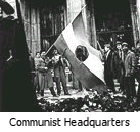
| How
did the flag get the hole in 1956? |
|
|
|
According to the Hungarian Constitution, the flag of Hungary is a red-white-green tricolor. Red stands for strength, White for faithfulness, and Green for hope. However, the tricolor with the coat of arms in it is more or less used as the de facto national state flag. The Coat of Arms, including the Crown of St Stephen, were formally re-adopted as the "lesser arms" by in 1990, while their inclusion on the flag was made official under restricted circumstances in 1995.
After the illegal communist takeover in 1948, the hated Rákosi regime established a new flag, replacing millenia-old Hungarian symbols with the Soviet-style communist red star and hammer.
After the brutal repression of the Hungarian revolt, a new puppet government was established under Bela Kadar who established a new flag, with a slightly "lighter" Soviet flavor. In 1989, the communist regime finally collapsed for good. The Hungarian tri-color and the historic coat of arms are back. "October 23, 1956, is a day that will live forever in the annals of free men and nations. It was a day of courage, conscience and triumph. No other day since history began has shown more clearly man’s eternally unquenchable desire to be free, whatever the odds against success, whatever the sacrifice required." – Senator John F. Kennedy, later USA President, Jan.1961-Nov.1963, on the first anniversary of the Hungarian Revolution. AHF's work regarding the tragic events nearly 50 years
ago, dates back to the early days of the revolution and
thereafter assisting tens of thousands of refugees. In 1956 the
American Hungarian Federation activated the second Hungarian Relief
program for the refugees of the 1956 Hungarian Revolution, providing
$512,560.00. With the support of the American Hungarian Federation,
over 65,000 refugees arrived in the USA. Get involved and help us
continue our tradition of helping our community! For more information about AHF, please contact bryandawson@americanhungarianfederation.org |
|
"State" Flag Pre-1948 |
|
 |
|
|
Official Flag |
|
 |
|
|
Rákosi Flag 1948 - 1956 |
|
 |
|
|
Revolutionary Flag with cut-out Hole 1956 |
|
 |
|
|
Revolutionary Flag with Kossuth Arms 1956 |
|
 |
|
|
Kádár Flag |
|

 The
heraldic right side of the Coat of Arms is divided by red and white
stripes seven times representing the seven Hungarian tribes that
arrived in Transylvania in 896 A.D. and are called the "Árpád-stripes".
The four white stripes represent the four main rivers of the historic
Hungary: Duna, Tisza, Dráva, Száva. On the heraldic
left side, the three green hills represent the three main mountains
of the historic Hungary: Tátra, Fátra, Mátra.
After 1920, only theMátra range remained in Hungary. On the
hilltop, from an open crown, the "apostolic" double cross
emerges which was awarded by pope II. Sylvester to Saint Stephen,
the first Hungarian king (1000 A.D.), in recognition of his mission
to turn the pagan Hungarians to Christianity.
The
heraldic right side of the Coat of Arms is divided by red and white
stripes seven times representing the seven Hungarian tribes that
arrived in Transylvania in 896 A.D. and are called the "Árpád-stripes".
The four white stripes represent the four main rivers of the historic
Hungary: Duna, Tisza, Dráva, Száva. On the heraldic
left side, the three green hills represent the three main mountains
of the historic Hungary: Tátra, Fátra, Mátra.
After 1920, only theMátra range remained in Hungary. On the
hilltop, from an open crown, the "apostolic" double cross
emerges which was awarded by pope II. Sylvester to Saint Stephen,
the first Hungarian king (1000 A.D.), in recognition of his mission
to turn the pagan Hungarians to Christianity.